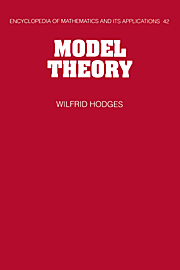Book contents
- Frontmatter
- Contents
- Introduction
- Note on notation
- 1 Naming of parts
- 2 Classifying structures
- 3 Structures that look alike
- 4 Automorphisms
- 5 Interpretations
- 6 The first-order case: compactness
- 7 The countable case
- 8 The existential case
- 9 The Horn case: products
- 10 Saturation
- 11 Combinatorics
- 12 Expansions and categoricity
- Appendix: Examples
- References
- Index to symbols
- Index
5 - Interpretations
Published online by Cambridge University Press: 08 October 2009
- Frontmatter
- Contents
- Introduction
- Note on notation
- 1 Naming of parts
- 2 Classifying structures
- 3 Structures that look alike
- 4 Automorphisms
- 5 Interpretations
- 6 The first-order case: compactness
- 7 The countable case
- 8 The existential case
- 9 The Horn case: products
- 10 Saturation
- 11 Combinatorics
- 12 Expansions and categoricity
- Appendix: Examples
- References
- Index to symbols
- Index
Summary
She turnd hersell into an eel,
To swim into yon burn,
And he became a speckled trout,
To gie the eel a turn.
Then she became a silken plaid,
And stretched upon a bed,
And he became a green covering,
And gaind her maidenhead.
Scots ballad from F. J. Child, The English and Scottish Popular Ballads.Since 1797 we have known (thanks to Caspar Wessel) that the complex numbers can be thought of as points in the real plane. Since 1637 we have known (from Descartes) that the points in the real plane can be identified by their cartesian coordinates. So in two steps we see that a complex number is really an ordered pair of real numbers. This insight is called an interpretation of the complex numbers in the reals. It takes two reals for each complex number, so the interpretation is said to be two-dimensional.
An interpretation of an L-structure B in a K-structure A involves four things: the structures A and B, and the languages K and L. There is a map that takes A to B; in fact we shall see in section 5.3 that this map is a functor taking any structure A′ enough like A to a structure B′ rather like B. (For example the construction of complex numbers from real numbers works equally well if one starts from any real-closed field.) There is also a map from L to K: it translates statements about B into statements about A.
- Type
- Chapter
- Information
- Model Theory , pp. 201 - 263Publisher: Cambridge University PressPrint publication year: 1993



